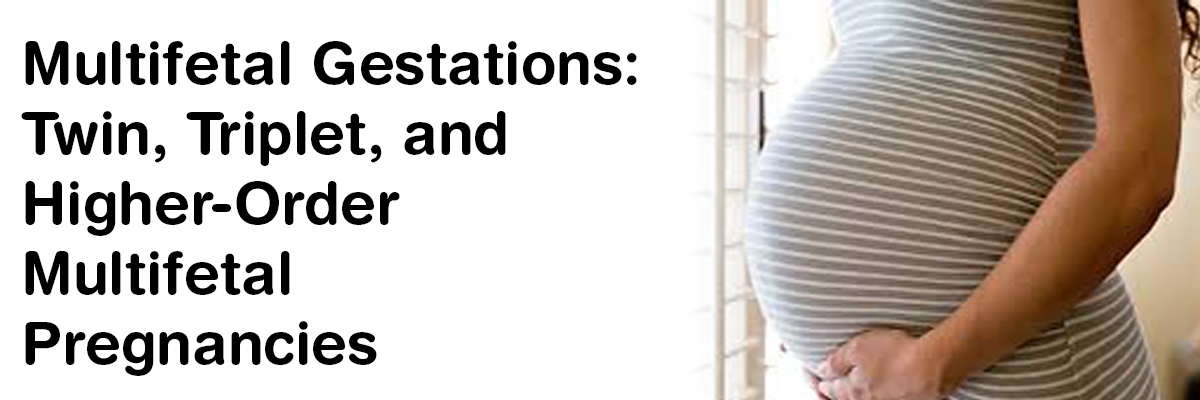
 IJCP Editorial Team
IJCP Editorial Team
Multifetal Gestations: Twin, Triplet, and Higher-Order Multifetal Pregnancies
The incidence of multifetal gestations is increasing dramatically over the past several decades, which may be due to 1) a shift toward an older maternal age at conception, where multifetal gestations are more likely to occur naturally, and 2) increased use of assisted reproductive technology (ART), which frequently causes multifetal gestation.
Many perinatal complications are increased with multiple gestations, like fetal anomalies, preeclampsia, and gestational diabetes, with preterm birth and the resultant infant morbidity and mortality is the most consequential complications. Multiple interventions have been evaluated for prolonging these gestations and improving outcomes, but none has shown a substantial effect.
A recent study established the following
recommendations and conclusions based on good and consistent scientific
evidence (Level A):
- The prophylactic use of any tocolytic agent in women with multifetal gestations does not have any role, including the prolonged use of betamimetics for this indication.
- The incidence of spontaneous preterm birth in unselected women with twin or triplet gestations cant be reduced with Progesterone treatment and, hence, is not recommended.
- Serial ultrasonographic evaluation is recommended about every 2 weeks starting at around 16 weeks of gestation in monochorionic gestations to scan for twin-to-twin transfusion syndrome.
The study also established the following
recommendations and conclusions are based on limited or inconsistent scientific
evidence (Level B):
- Women, who opt for pregnancy reduction from triplets to twins, when compared with women who continued with triplets, were observed to have shown lower frequencies of pregnancy loss, antenatal complications, preterm birth, low-birth-weight infants, cesarean delivery, and neonatal deaths, with rates comparable to those seen in women with spontaneously conceived twin gestations.
- The chorionicity of a multifetal pregnancy should be confirmed at the earliest possible stage of pregnancy, with the optimal timing for determination by ultrasonography being the first trimester or early second trimester.
- Routine prophylactic interventions like cerclage, hospitalization, bed rest, tocolytics, and pessary have not been proved to decrease neonatal morbidity or mortality, and thus should not be used based exclusively on the indication of multifetal gestation.
- Except in case of any contraindication, a course of antenatal corticosteroids should be administered to all patients who are at risk of delivery within 7 days and who are between 24 weeks and 34 weeks of gestation, irrespective of the fetal number.
- Magnesium sulfate reduces the severity and risk of cerebral palsy in surviving infants if given when the birth is anticipated before 32 weeks of gestation, irrespective of the fetal number.
- Women with one previous low transverse cesarean delivery, who are otherwise suitable candidates for twin vaginal delivery, may be deemed candidates for a trial of labor after cesarean delivery.
The study rendered the following recommendations
and conclusions based primarily on consensus and expert opinion (Level C):
- All women with multifetal gestations, regardless of age, should go for routine screening for fetal chromosomal abnormalities.
- The optimal gestational age for starting surveillance in pregnant individuals with uncomplicated dichorionic twins is unknown. However, weekly antenatal fetal surveillance may be considered at 36 0/7 weeks of gestation for these patients.
- For patients with a dichorionic twin pregnancy complicated by maternal or fetal disorders like fetal growth restriction, antenatal fetal surveillance should be personalized and may be viewed upon diagnosis, or at a gestational age following which delivery would be considered for abnormal testing.
- Women with uncomplicated monochorionic–monoamniotic twin gestations can experience delivery at 32 0/7–34 0/7 weeks of gestation.
- Women with monoamniotic twin gestations should undergo cesarean delivery to avoid an umbilical cord complication of the non-presenting twin at the time of the initial twin’s delivery.
- In diamniotic twin pregnancies at 32 0/7 weeks of gestation or later with a presenting fetus that is vertex, regardless of the presentation of the second twin, vaginal delivery is a valid option and should be considered, provided that an obstetrician with experience in managing a nonvertex presenting second twin is present.
- Neuraxial analgesia, when given to women with multifetal gestations, eases operative vaginal delivery, external or internal cephalic version, and total breech extraction.
SOURCE- Multifetal Gestations: Twin, Triplet, and Higher-Order Multifetal Pregnancies, Obstetrics & Gynecology: June 2021;137(6): e145-e162 doi: 10.1097/AOG.0000000000004397

IJCP Editorial Team
Comprising seasoned professionals and experts from the medical field, the IJCP editorial team is dedicated to delivering timely and accurate content and thriving to provide attention-grabbing information for the readers. What sets them apart are their diverse expertise, spanning academia, research, and clinical practice, and their dedication to upholding the highest standards of quality and integrity. With a wealth of experience and a commitment to excellence, the IJCP editorial team strives to provide valuable perspectives, the latest trends, and in-depth analyses across various medical domains, all in a way that keeps you interested and engaged.





















Please login to comment on this article